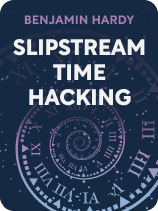

This article is an excerpt from the Shortform book guide to "Slipstream Time Hacking" by Benjamin Hardy. Shortform has the world's best summaries and analyses of books you should be reading.
Like this article? Sign up for a free trial here.
What’s time hacking? Can you manipulate time?
Benjamin Hardy argues that you can get more out of your life if you take advantage of the relativity of time. He believes you can live the equivalent of many lifetimes in the years you have by using a technique called “slipstream time hacking.”
Keep reading to learn more about the concept of slipstream time hacking.
What’s Slipstream Time Hacking?
The word “slipstream” refers to the force that makes it easier to travel faster right behind a fast-moving object. “Time hacking” describes making radical changes to get the most out of your days and years. Put them together, and you get slipstream time hacking: a method for finding shortcuts that bring you to your goals in less time and with less effort than you would otherwise have to spend on achieving them.
(Shortform note: While Hardy is speaking metaphorically about living multiple lifetimes, some might argue that it would be literally possible to do so if you could shift how you perceive time. We perceive time as linear, but some experts say that’s an illusion. We can imagine reality as a three-dimensional space where things happen over time or as a space where time is a fourth dimension and the past, present, and future exist all at once. In the 2016 film Arrival, for example, extraterrestrials who perceive time nonlinearly and nonsequentially understand life more deeply. In the film, living multiple periods of your life at once helps you experience it all more richly, just as using slipstream time hacking to slow time can help you find more meaning in your life.)
To understand his method for making the most of your time on Earth, Hardy asks you to reframe how you think about time. An easy way to understand this is to consider how vast distances in outer space are measured in light-years: the distance that light travels in a year.
Imagine that you’re an astronaut planning a mission to a distant planet. You might take note of the distance between Earth and this distant planet in light-years, but your spaceship doesn’t travel at the speed of light. So, even if the planet is only one light-year from Earth, it will take much longer than a year to get there. (If you’re borrowing a spacecraft from NASA, it could take 17,000 years!) Hardy contends that using slipstream time hacking is like traveling the distance from Earth to that remote planet at the speed of light instead of at the typical speed for your spaceship. You’re covering the same distance but doing it in much less time than would typically be possible.
(Shortform note: Measuring distances in light-years seems counterintuitive. But engineer Bill Nye explains that this is an excellent solution for measuring and describing the vastness of our universe. He points out that it takes light only 8.3 minutes to get from the sun to the Earth, a distance of 93 million miles. In a year, light can travel much farther than that: a total of 5.88 trillion miles. Nye says astronomers chose light-years as a unit of measurement to make the distances between objects in space more manageable to think and write about. Unconventional units like light-years can help us understand how vast our universe is—and envision how time-consuming it would be to travel around it, even if we could travel at the speed of light.)
In the same way that astronomers use light-years to describe vast distances in outer space, Hardy explains that you can think about the years of your life in terms of the distance you cover, rather than the time that elapses as you work toward your goals. For example, if you can find a way to write a novel in a single year—even though everyone’s told you it’ll take two or three years to get it done—you’ve found a way to cover more distance in that year, writing an entire book instead of just a third or a half of one. You’ve effectively slowed time down. As Hardy notes, that enables you to accomplish more in a finite amount of time and build a more meaningful life than one spent rushing around in pursuit of your goals.
(Shortform note: You can think of Hardy’s advice—to imagine distance traveled rather than time elapsed—as an argument for focusing on the quality, rather than the quantity, of time you get in your life. Much research in the social sciences leads back to this trade-off. That includes the longest-running study on happiness, which found that the depth of our relationships strongly predicts our well-being. While spending more time with someone can deepen your relationship, the goal isn’t so much to increase the quantity of time spent together as to enrich the quality of your connection. In keeping with Hardy’s strategy, you might think of time as a resource that’s valuable not for its own sake but for what it enables you to experience with the people you love.)
Hardy explains that the idea of slipstream time hacking isn’t to speed up the process of achieving your goals so that you can set and achieve even more goals. It’s the opposite: He contends that you must focus on just a few of your most meaningful priorities to live the most meaningful life. That doesn’t mean that he wants you to think small. Rather, he contends that your dreams should be so big that they require help from forces—like relativity, time dilation, slipstreams, and wormholes—that would sound right at home in the most imaginative work of science fiction. Let’s examine these principles to see how they make slipstream time hacking possible.
1. Relativity
The first principle of slipstream time hacking is the relativity of time: the idea, stated by Albert Einstein, that time isn’t as objective as it seems. Instead, it depends on your frame of reference. (Shortform note: In A Brief History of Time, theoretical physicist Stephen Hawking explains that as you approach the speed of light you move more quickly through space—but more slowly through time. This is because time moves relative to the observer. So if you’re moving a lot faster than somebody else, you perceive less time passing than they do.)
To wrap your head around how the relativity of time works, picture two astronauts, Audrey and David. Audrey goes to space and travels at the speed of light, while David stays on Earth. From David’s perspective, Audrey’s journey lasts many years. However, due to the high speed of her travel, time slows down for Audrey. When she returns to Earth, she feels only about a year older. So she’s surprised to see that David has aged dramatically. This is the relativity of time: the idea that time can speed up or slow down depending on an observer’s speed.
There are only 24 hours in a day. But Hardy writes that by taking advantage of the relativity of time, you can find more time each day to do the things that make you happy. This works because when you change the speed at which you’re traveling toward your goals, you also change how you perceive time. The rate at which time seems to pass depends entirely on your frame of reference as you’re experiencing it, just like for the astronauts in our example.
(Shortform note: Hardy recommends doing more with your time, but not at the expense of living a meaningful life. Many thinkers have observed that we become so busy that we forget our own mortality and waste time on things that don’t matter to us. This is damaging because some people believe our mortality gives our lives meaning. In When Breath Becomes Air, neurosurgeon Paul Kalanithi writes that we have to choose to make meaning of our lives even as we face the inevitability of death. That’s what Kalanithi did after being diagnosed with lung cancer as he was finishing his medical training. He describes time losing its meaning: He wanted to fit as much life as possible into each day, as Hardy advises, but cancer made that difficult. So he focused on being present with his family.)
2. Time Dilation
The second principle of slipstream time hacking is that time slows as you move more quickly, as the principle of relativity suggests. This phenomenon is called time dilation. Hardy adopts the concept to explain how making faster progress toward your destination can feel like buying yourself more time to do something meaningful. (Shortform note: Time dilation means that when you move very quickly, you experience time passing more slowly. Because time is relative to speed and gravity, time dilation happens not only when you travel faster but also when you spend time where gravity is stronger. For example, time moves slower at the bottom of the ocean than at the surface and faster at the top of a mountain than at sea level.)
Hardy contends that you can use time dilation to your advantage. Let’s say you’re racing against a deadline to finish a difficult project at work. At first, you feel stressed by the number of hours you have: Each one feels insufficient as you try to figure out how to get the work done. But as you make progress, your pace speeds up and time seems to stretch. Each hour starts to feel productive, and the minutes pass more slowly. In other words, the more quickly you move, the more time seems to slow—and the more time you seem to have to complete the project.
(Shortform note: Time dilation can be a powerful tool for getting the most out of your time, as illustrated by science fiction stories that involve space travel. In Ken Liu’s short story “Memories of My Mother,” a terminally ill mother uses time dilation to expand the two years she has left. She travels to space and returns periodically so she can see her daughter grow up, making the most meaningful use of her limited time.)
3. Slipstream
A third principle crucial to Hardy’s method is that a force called slipstream makes it easier for you to travel quickly if you follow in someone else’s wake. In science fiction, the term “slipstream” describes traveling through space at speeds faster than light. But in basic physics, a slipstream refers to the current of air or water driven backward by a fast-moving object, like a marathon runner. When another runner follows behind the first runner, they can travel just as rapidly as the first—without expending as much energy to counter the wind resistance and maintain their speed as they’d have to if they were running alone.
(Shortform note: Slipstream is often explained by describing runners, cyclists, or sailors trying to win a race. But humans aren’t the only animals to take advantage of this basic principle of physics to get where they’re going without tiring themselves out too much. Scientists say that baby whales and dolphins rest, eat, and sleep as they coast in their mothers’ slipstreams. Because the water around the mother is moving at about the same speed that she is, the calf can just ride along with her, staying afloat and on course. Their ability to float in their mothers’ slipstream is particularly useful because when whales and dolphins are newborns, they don’t yet have enough body fat or blubber to stay buoyant on their own.)
Hardy explains that when you enter someone else’s slipstream, you experience a big change in velocity. (In other words, your speed increases very quickly.) He warns that this can feel uncomfortable in the moment. But following the time, money, skill, or energy other people have invested into accomplishing something gets you to your destination more quickly. By jumping in at their velocity, you can go farther (and at faster speeds) than you would if you had to build your own momentum. When you’re in someone’s slipstream, you’re following a shortcut and benefiting from what they’ve learned and accomplished.
To visualize how this might work, imagine that you’re an aspiring chef and want to open your own restaurant. So you apprentice with an award-winning chef you’ve admired for years. In her kitchen, you observe her, learn her methods, and get introduced to her colleagues and investors. By following in her slipstream—a force created by her experience, knowledge, and influence—you make significantly faster progress toward your goals than you would alone.
(Shortform note: When Hardy talks about riding in someone’s slipstream, he’s talking about leveraging your access to people with power, resources, and social capital. However, that access is a privilege that not everyone has. So You Want to Talk About Race author Ijeoma Oluo explains that privilege is about having advantages that others don’t: You might have privilege because of your race, gender, religion, or socioeconomic status. That doesn’t mean you haven’t worked hard—just that you haven’t encountered the obstacles others face because of their identity or background. To see your privilege, scholar Peggy McIntosh says you must consider your personal experiences in the context of larger “patterns and systems in social life.”)
4. Wormholes
A fourth principle of Hardy’s method is that you can use wormholes to take shortcuts that reduce the time and effort needed to reach your goal. Hardy defines a “wormhole” as a shortcut that gets you to your goal in a nonlinear way. Importantly, not only does a wormhole enable you to spend less time traveling to your destination, but it also enables you to expend less effort getting there. Wormholes, as physicists define them, are theoretical. They’re thought to serve as a shortcut between two points in space separated by extremely long distances (like two locations on opposite sides of the galaxy). So finding a wormhole and traveling through it enables you to make incredible leaps toward your goals by reducing the distance you need to travel to get where you want to go.
(Shortform note: One way to visualize how traveling through a wormhole might get you to your goals faster is to think about a classic illustration from Madeleine L’Engle’s A Wrinkle in Time. In the book, the characters travel through the universe via the tesseract: a fold in the fabric of space-time. When Mrs. Who and Mrs. Whatsit, supernatural characters who live outside linear time, explain their mode of interdimensional travel, they ask their audience to imagine an ant walking along a piece of fabric, traveling from point to point. If the fabric is folded to bring the two points together, the ant has a much shorter distance to travel. In the same way, traveling through a wormhole reduces the distance between you and your destination.)
Hardy considers traveling through wormholes an essential strategy for accomplishing big things. He believes that for most goals, you can find a wormhole that will change your life instantaneously. While finding wormholes comes down to luck, Hardy argues that you can create this luck by seeking it out. One way to do this is to travel in faster slipstreams, where you’re more likely to encounter a wormhole.
For example, let’s say you’re a writer who’s been struggling for years, writing and rewriting your novel and pitching it to dozens of agents with no luck. Then, you decide to go to a publishing industry conference, and at a party, you meet a literary agent who loves the idea of your book, has been looking for something just like it, and wants to read the manuscript. That unexpected connection presents a wormhole: an opportunity that could dramatically shorten the path between you and your goal of publishing your novel.
(Shortform note: If finding slipstreams and wormholes hinges on having access to accomplished or powerful people, then knowing the right people becomes extremely important. It also helps to be related to the right people, as demonstrated by the results of legacy admissions at elite universities. (The children of alumni and donors are four times as likely as their peers with the same test scores to be admitted.) The phenomenon of people benefiting from family connections is nothing new. But the internet recently invented the term “nepo baby,” which experts say expresses the frustration we feel watching some people benefit from unequal treatment and unfair advantages when we want to believe in meritocracy.)
Find Other People Moving in the Same Direction You’re Going
Traveling alongside people who are slowing time represents the importance of a support system because not everyone will understand what you’re doing. Hardy notes that, when you use slipstream time hacking, you’re departing from the status quo and acquiring knowledge or experiencing change at a pace that might feel unfamiliar to others in your life. Some people who don’t understand what you’re doing might try to discourage you. For example, people in Picasso’s time didn’t understand what he was doing in his paintings. But, by developing Cubism, he pushed art forward at an incredible speed—even if people didn’t like how his paintings demanded that they look at art in a new way.
(Shortform note: As Hardy points out, people aren’t always supportive or understanding when you make big moves in your career. So experts like Tony Robbins contend that you should surround yourself with people who challenge and inspire you. Similarly, in Who Will Cry When You Die?, Robin Sharma explains that it’s crucial to benefit from the support and wisdom of other people as you work toward fulfilling your purpose in life. He recommends building a group of three or four friends committed to supporting each other as you each pursue your goals. He also writes that many people benefit from hiring a life coach, trying to meet their heroes, and putting effort into building strong friendships that not only give them support but also bring them joy.)
Hardy recommends that, as you find your path, you should also seek out ways to help other people slow down time, too. He explains that the goal should be for everybody to slow time and live more meaningful lives as individuals and as a community. If we all work together, everyone can learn to slow time in their own lives. You can help others toward that goal by using your skills in slipstream time hacking.
(Shortform note: Many people agree with Hardy that we should use our advantages and access to create opportunities for others to live better lives. But others think it’s also important for people with power and privilege to tear down the systems that afforded them those benefits in the first place, creating a more just world for everyone. Feminist writer and philosopher Audre Lorde famously wrote, “The master’s tools will never dismantle the master’s house.” Lorde warned that we can’t use the tools of oppressive systems to liberate ourselves or others from the inequality caused by those systems. That might be an argument for using slipstream time hacking not to succeed within existing systems but to forge new paths for yourself and others.)

———End of Preview———
Like what you just read? Read the rest of the world's best book summary and analysis of Benjamin Hardy's "Slipstream Time Hacking" at Shortform.
Here's what you'll find in our full Slipstream Time Hacking summary:
- That your far-off goals might be closer than you think
- How to buy more time by making time run slower
- Why you might want to apply Einstein’s theory of relativity to your life






